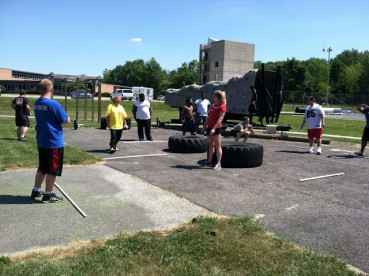CrossFit Confidence
Reprinted with permission from Outreach, Inc.
Everyone else is finished, but one young man hangs from a bar, only halfway done with the morning’s exercise routine at the CrossFit gym at the corner of 10th and Post Road on Indianapolis’ eastside. He’s already completed half of the sets of wall balls and toe to bars, but with more than 100 reps left to go, sweat pours down his face and his eyes register a temptation to surrender to the fatigue.
Squatting less than three feet away, Eric Howard, Outreach’s founder and CEO, urges the youth to pull his dangling feet to the bar once more. “I know it hurts,” Howard half yells, “but you got this.”
Slowly, laboriously, the young man completes the set of toe to bars and moves on to another round of wall balls, an exercise that consists of bouncing a 20-pound ball off a black target on the wall.
Across the gym, Israel Vasquez cools down after completing the set. When Israel first started training at CrossFit back in April, he weighed 227 pounds and wore size 38 pants. Thirteen weeks later, he’s bumped down to a 32 and weighs in at 185.
Since April 2012, Outreach has been partnering with CrossFit, a strength and conditioning program used to train police officers and special operations teams across the country, in this case members of the Indianapolis Metropolitan Police Department (IMPD) and the Indianapolis Fire Department (IFD). Historically, the relationship between Indianapolis’ homeless youth and the police department has been a strained one, but CrossFit is breaking down barriers as 6-10 Outreach youth and volunteers exercise side by side every week with IMPD and IFD officers.
“When they first started coming, they were all nervous because of the cops,” says Erin Wright, IFD private, who works at CrossFit and volunteers to help while the youth are working out. “There’s an ease now when they come in the door.”
Some officers, she says, have seen youth on the streets and waved to them, after working out with them at CrossFit.
Beyond beginning the slow process of mending perceptions between the two groups, it seems that CrossFit has begun to repair confidence issues typical of many homeless young people who have faced things like abandonment, abuse, and neglect.
“There are not many people in their lives pushing them and cheering them on,” Wright explains. “You see that switch, when one little accomplishment can change everything.”
 “It is amazing to see a young person who struggles in his or her value and worth to accomplish a tough workout of the day and not give up,” Howard adds. “To recognize that they just completed something that they thought was impossible, this allows the conversation to occur about making choices to ‘give up’ or ‘give in.’ It focuses a young lady to realize she is stronger than what she realized. To go from selling yourself to survive to recognizing that you are stronger than that—is huge. The sense of community created is dynamic—like seeing youth go from being self-focused to cheering on another youth to finish the workout well!”
“It is amazing to see a young person who struggles in his or her value and worth to accomplish a tough workout of the day and not give up,” Howard adds. “To recognize that they just completed something that they thought was impossible, this allows the conversation to occur about making choices to ‘give up’ or ‘give in.’ It focuses a young lady to realize she is stronger than what she realized. To go from selling yourself to survive to recognizing that you are stronger than that—is huge. The sense of community created is dynamic—like seeing youth go from being self-focused to cheering on another youth to finish the workout well!”
Vasquez has definitely felt his confidence rise, while his weight was dropping.
“It’s great—the endurance, the rush! There’s a lot of motivation,” he says. “When I have somebody in my face telling me I can do it, I can just monster right through it.”
As well, street outreach worker Luke Mertes says he has seen how Outreach has helped many of the guys he meets on the streets deal with stress:
“[Exercise] has drastic implications for how they respond to stressful situations and the coping mechanisms all humans develop to deal with that stress. I predict much less jail time, drug abuse, anger outbursts, STD infections, unwanted pregnancies, and more for those who go through CrossFit.”






